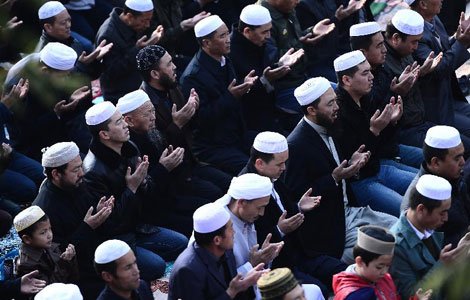Safeguard regional harmony
Updated: 2013-10-18 08:12
By Peng Guangqian (China Daily)
|
|||||||||||
China is in dialogue with neighbors regarding South China Sea disputes that arose following the discovery of resources
An important aspect of Chinese military thinking can be illustrated by the teaching of Chinese military strategist Sun Tzu in the Spring and Autumn Period (770 - 476 BC). His teachings state that the supreme art of war is to subdue the opponent without fighting. This speaks volumes for the core value of the Chinese culture represented by the character "he", referring to peace, reconciliation and harmony, which continues to retain significance for today's world.
Today, the Western media often play up the "China Threat", as if it was a great power suddenly emerging out of nowhere. China had long ranked top in terms of naval power, at least before the Ming Dynasty (1368-1644). This can be testified by the seven expeditions made by explorer Zheng He sponsored by the Ming rulers, almost a century ahead of Christopher Columbus's discovery of the "New World".
Rather than bloodshed and colonialism, the most powerful fleet in the world gave porcelain, silk and tea, which brought the Ming Dynasty decades of harmonious relations with its neighbors.
Its isolation from the outside and the corruption of the Qing Dynasty (1644-1911) imperial court, however, led to national backwardness and ensuing suffering at the hands of imperialists, but it has also risen from rubble. Today, the country is determined to pursue a path of peaceful rising and never before has it been so confident in national rejuvenation.
As for the analysis of China returning to the Pacific, it is in fact not analytical at all. China has always been a Pacific country and has never reduced its presence in the region. China is more concerned about peace and stability in the Pacific than any other country and hopes to see a truly "pacific" ocean. Sadly, the landscape is not that harmonious due to recently troubled waters in the South China Sea.
China was the first to discover, develop and exercise effective jurisdiction over islands and reefs in the South China Sea. The country had more than once solemnly reiterated its stand for its maritime rights and interests in the region, before the United Nations Convention on the Law of the Sea came into force in 1994. Beijing issued a statement on its territorial sea in 1958, specifically listing the Nansha and Xisha islands as Chinese territory. Ten days later, then Vietnamese premier Pham Van Dong sent a diplomatic note to his Chinese counterpart Zhou Enlai saying that the Democratic Republic of Vietnam recognized and supported the declaration by the Chinese side.
Nonetheless, the South China Sea has been turned into troubled waters since it was found to be abundant in marine resources. Also under the UNCLOS, coastal states are given the right to an exclusive economic zone 200 nautical miles from the baselines from which their territorial sea is measured, which sows the seeds of escalating the disputes in the resources-rich waters.
Mired in a mess of "cultural revolution" (1966-76), China was tied up tackling massive social upheaval, and from that period on Vietnam and the Philippines have occupied most of the islands and reefs in the region. Vietnam has occupied 29 of them and denied its previous diplomatic note, excusing itself based on the special bilateral ties at that time, and saying the note was released in a "complicated and urgent context", in which war with the United States was escalating. Such inconsistency is a sufficient cause for national disgrace.
On the premise that the sovereignty of the territories concerned belongs to China, Chinese leader Deng Xiaoping advanced the concept of "setting aside disputes and pursuing joint development". As an embodiment of China's "he" value, it provides a win-win and mutually beneficial approach for the peaceful settlement of the disputes.
In 2002, China and Association of Southeast Asian Nations signed the Declaration on the Conduct of Parties in the South China Sea in Phnom Penh. It attached great importance to friendly negotiation and consultation to solve the disputes through peaceful means and urged all parties to maintain restraint and refrain from complicating and escalating the disputes. Disappointingly, some parties have deliberately resorted to the use of non-dialogue means and even force.
Although international treaties such as the Treaty of Paris (1898) between the US and Spain defined 118 degree east longitude as the western limit of Philippine territory, and the Huangyan Island is obviously outside the defined border, Manila sent a warship to harass Chinese fishing vessels which sailed into the waters of Huangyan Island to shelter from bad weather last year.
In May, a fishing boat from Taiwan was fired on from an armed Philippine vessel in the disputed waters and the captain of the fishing boat was killed. Even if there was an intrusion, there was no reason to spray bullets at a civilian vessel.
For thousands of years, Chinese culture has embraced the Confucian philosophy that "harmony is of paramount importance where the rites apply". China will unswervingly stick to the path of a peaceful rise. The use of force will not be the first choice of a country that cherishes the "he" value so much, but it is noteworthy that it has to be the last resort to defend State sovereignty and territorial integrity.
The author is deputy secretary-general of the National Security Policy Committee under the China Association of Policy Science Study.
(China Daily 10/18/2013 page8)
Related Stories
China, ASEAN South China Sea meetings scheduled 2013-09-10 18:18
US boosts troops in Philippines amid South China Sea tension 2013-08-31 01:58
Wave warning issued for South China Sea 2013-07-19 21:46
China hopes to maintain South China Sea peace 2013-07-19 17:39
South China Sea seamount named after Jiaolong 2013-06-27 05:05
Jiaolong completes dive in South China Sea 2013-06-18 02:23
Today's Top News
Xi: Expand Australia ties
Chinese millennials worried about finances
Investigation to diagnose nation's TCM resources
Elderly group sorry about roles in turmoil
Cartoon featuring Xi shows how to be president
US not budging on its arms restrictions on China
Beijing criticizes Abe's shrine offering
UK hails Chinese nuclear investment
Hot Topics
Lunar probe , China growth forecasts, Emission rules get tougher, China seen through 'colored lens', International board,
Editor's Picks

|

|

|

|

|

|





